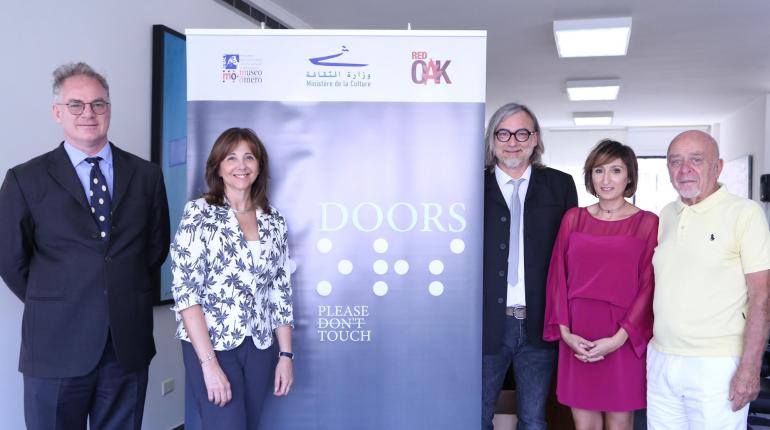
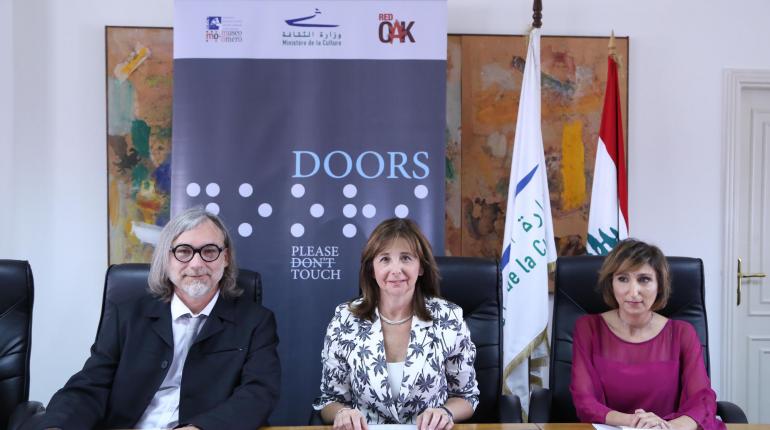
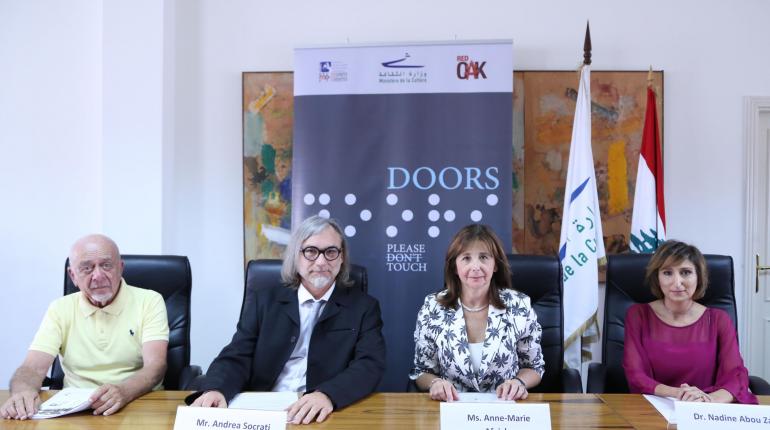
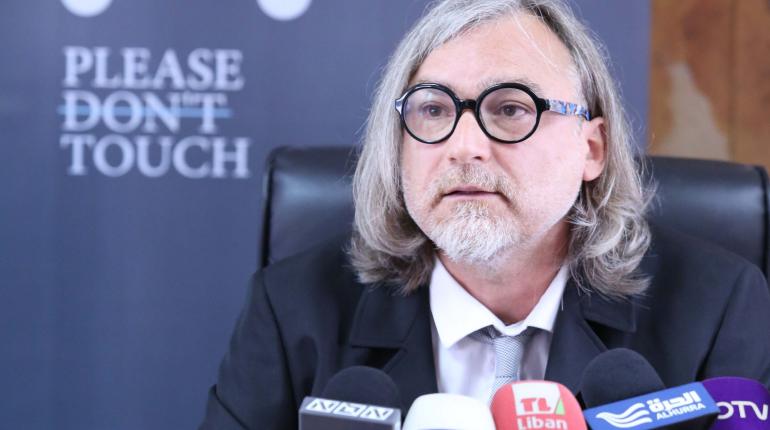
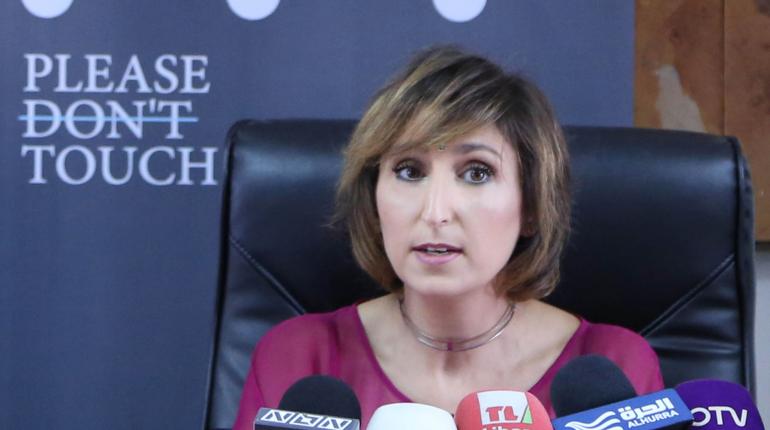
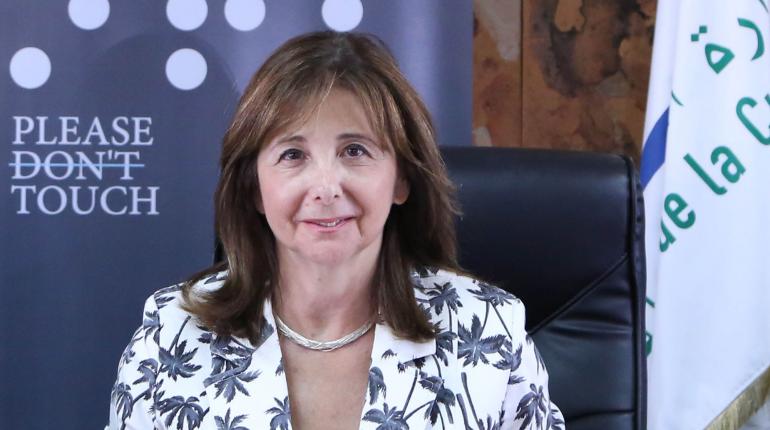
Red Oak, in partnership with the “Omero” Tactile National Museum of Italy, Opens the Doors of Museums to the Blind
Under the patronage of the Ministry of Culture, Red Oak Association in partnership with the “Omero” Tactile National Museum of Ancona in Italy, launched “Doors. Please Touch” project for the blind and visually impaired, a one of a kind in Lebanon and the region.
This launching took place at a press conference held at the Ministry of Culture on July 3, 2018 under the patronage of H.E. Minister of Culture Dr. Ghattas Khoury, represented by the Director General of the Council of Museums Ms. Anne-Marie Afeiche. Mr. Andrea Socrati, Responsible for Special Projects of the Omero National Museum and Dr. Nadine Abou Zaki, Red Oak Founder and President, participated in the press conference along with Ms. Afeiche.
The press conference discussed the ways to facilitate the entrance of the blind to museums in Lebanon and the possibilities of a tactile way to art for everyone.
The project is in collaboration with the National Museum of Beirut, Sursock Museum and MACAM (Modern and Contemporary Art Museum).
Anne-Marie Afeiche
Ms. Anne-Marie said: “The Museums of Lebanon, like all museums around the world, have a mission towards society, that of working for its development, for the education of its people but also for their leisure. Being open and available to all audiences is an obligation. The tangible and intangible heritage of humanity is conveyed to museums and should therefore be accessible to all.
Support for the blind and visually impaired and for all those with special needs has always been respected in Lebanon. But today and for the first time we are delighted to have the ability to apply a method thanks to a professional training that will be offered to us by the Omero National Museum of Ancona, represented by Mr. Andrea Socrati, upon the initiative of the Red Oak Association represented by Red Oak Founder and President Mrs. Nadine Abou Zaki.
In fact, we can only thank all those who will allow us to offer a better service to the blind and visually impaired visiting our museums.”
She added: “The National Museum is now ready to initiate this project and will expand its area of action once teams are formed at other national museums, namely in our regions of Baalbeck, Jbeil, Tripoli and Beiteddine. Similarly, this training will be integrated into the new projects of museums being established: the Museum of the history of Beirut in the center of the capital, the Museum of Saida under construction, the Museum of the archaeological site of Tyre, and the future project in Deir el Qamar. This project is also an association of private museums such as the Sursock Museum, particularly for its collections of modern and contemporary paintings and the MACAM Museum for its rich collection of sculptures.”
She concluded: “All the museums of Lebanon are invited to join this challenge: that of making the blind or visually impaired appreciate purely visual works. But it is also our concern and our duty to find new ways of mediation and to develop a multi-sensory approach to enable everyone to access our common heritage.”
Andrea Socrati
Mr. Socrati in turn said that “The meeting of the Omero Museum with the Red Oak Organization gave life to the project “Doors. Please touch” that we present today.”
“The project aims to promote the social and educational value of cultural heritage through an innovative approach to the heritage itself, based on multi-sensory experiences and in particular on touch, focused primarily on the cultural and social inclusion of people with visual disabilities, but with the goal to develop new ways of approaching cultural heritage valid for all,” he added.
“Touching is generally prohibited in museums,” he explained. “Yet the sense of touch is the main tool of knowledge for blind people, therefore preventing them from touching works of art, objects and artifacts, means denying access to cultural heritage.”
Socrati also explained that “the project wants to develop skills aimed at disseminating in the museums inclusive educational services touch tours, audio-descriptions and other multi-sensory experiences tailored for people with visual impairment as well as multi-sensory museum paths usable by blind people.”
“The development of museum programmes accessible for people with visual disabilities is nevertheless functional to the renewal and strengthening of strategies for public engagement. At the same time the schools are involved in the realization of educational and inclusive activities to art and cultural heritage,” he noted.
Socrati highlighted the importance of the project to the people with visual disabilities who are involved in the project not only as final recipients of museum experiences that the project can contribute to create, but also as protagonists of a research that aims to highlight their needs and expectations of culture.
“Finally, the project aims to raise awareness among educators, teachers and family members on the importance of art education for people with visual disabilities by creating tools and educational strategies for the artistic and aesthetic education of blind people,” he said.
He disclosed that “the project includes several stages of implementation, from staff training to educational strategies in schools, from the creation of accessible paths in museums to the proposal of multi-sensory activities for all.”
Nadine Abou Zaki
In her speech, Abou Zaki said that “Red Oak, founded in 2017, aims to promote new and innovative ideas through education, art and culture. It was born out of the following questions: In today's digital world, can image replace the sense of touch? And should arts be limited to a visual experience?”
“Trying to find an answer to these questions led me to carve my eyes closed in the dark. I started wondering where tactility fits into the artistic creation. This experience revealed to me that art was not only meant for the eyes, but that touching the works of art could trigger more intense and deeper emotions. What if we touched to see...? In the dark. Despite the dark. What if we re-explored our senses? What if we redefined together the art codes? This is how I invited visitors to break the taboo of “Please do not Touch” in museums by touching the sculptures in the dark in "Please Touch", an interactive sculpture performance initiated in 2014,” she added.
She also noted that “this is how the meeting with the Omero Tactile National Museum of Ancona took place. The museum was preparing for the publication of the book “Contemporary Art and the Discovery of the Values of Tactility” and contacted me in 2017 to introduce "Please Touch" in this book. The book was published this month. It is signed by Aldo Grassini, President of the museum, himself blind, and Andrea Socrati. What if we crossed the borders? Several months later, I suggested to Andrea Socrati a collaboration between Red Oak and the Omero museum, and together we launched “Doors. Please Touch”,” she said.
My recent trip to Ancona and my visit to the Omero museum confirmed to me that this partnership would be an opportunity for Lebanon to be innovative in art and become one of the few countries in the world to allow all the people without any exception to experience the touching of art,” she added.
She also pointed out that “"Doors, Please Touch" is also the fruit of my encounter with the blind and visually impaired: children, youth and adults. It was in fact a series of touching encounters that brought me a lot of strength. Since the beginning of the year, Red Oak with its team of experts in special needs and professional artists, has launched a program for the disabled, in parallel with its environmental program and the "Red Oak Performing Troupe.”
“We jointly promise together, with the Omero National Museum, to offer the blind and visually impaired access to museums in Lebanon through a tactile guidance system and inclusive tactile educational activities. We shall also integrate in the project implementation the blind or visually impaired,” she affirmed.
Abou Zaki concluded by stating that “We believe that every individual has the right to creative expression and shall have the opportunity to participate in the arts, both as an artist and as a spectator. We are therefore committed to opening the doors of art to all in order to develop the exceptional potentials of perceiving / appreciating and practicing art, and in view of providing equal access to cultural heritage to all.”
